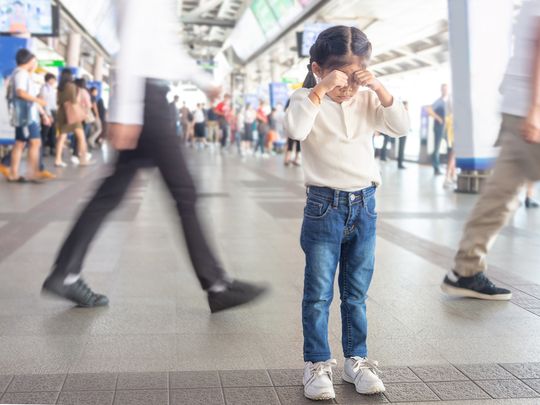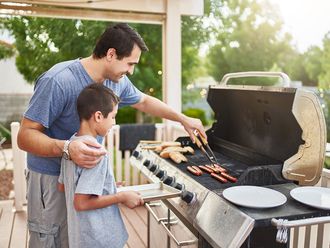
Ask any parent – one of their biggest fears is losing their child in a crowded place.
As technology evolves, more and more parents are learning that GPS (global positioning system) tracking is a useful feature that gives them peace of mind, in such situations. It’s also handy when you’re allowing your child to gain more independence – for instance, when your eight-year-old wants to walk to the bus stop on their own, or wants to buy something from the grocery store down the road.
There are several ways to keep track of your little one, and we highlight the most efficient devices below. However, we also spoke with Dr Dina Bedair, clinical psychologist and director of mental health services at Insights Psychology DMCC, who has more than 15 years’ experience in the mental health/psychology field. She shared valuable insights into the nuances of tracking your children, and how to pull back to give them more privacy and independence, as they grow older.
Dr Bedair said: “As with any technology, or parenting aid, as long as [surveillance] is used responsibly, and with the right intention, it can serve as a useful addition to an already existing repertoire of tools and strategies that a conscientious parent has to hand.”
She also highlighted an important step parents must take, before monitoring their children: “Tracking devices can help a lot, however, as these can be either lost or taken off by the child... an age-appropriate conversation around the specific device being used and what it means for the child is important. This can be kept simple using a more picture-based story approach for younger children or for those with language difficulties and becoming more sophisticated as the child grows and their language develops.”
Learn more about how to navigate this issue, below, and check out our curated list for the best devices to help you keep an eye on your child. Don’t forget to shop with Prime membership, for free, fast delivery.
1. Best Bluetooth Tracker: Apple AirTag
Pros
- Small, convenient size
- IP67 rating for water resistance
- Precise location finding abilities
- Built-in speaker
Cons
- Does not support GPS
Bluetooth trackers offer one of the most affordable ways to keep track of your children. Apple’s AirTag, for instance, leverages the brand’s huge network of devices to find what (or who) you’re looking for. Reviewers say they’re impressive in their accuracy, and allow you to pinpoint the tag’s precise location. The AirTag can slip into your child’s pocket, backpack, or in a custom-made AirTag bracelet, which you can buy separately. A simple one-tap set-up instantly connects the AirTag with your iPhone or iPad. If you’re using this tracker for items like car keys, it can play a sound on its built-in speaker to alert you about its location. However, do note that the AirTag doesn’t support GPS; instead, it relies on being close to an iPhone – at a proximity of about 15 to 30 feet. If there are no Apple devices nearby, the AirTag’s latest location will not update in the Find My app.
Warranty: Amazon offers one-year extended warranty by Salama Care for Dh23, and two-year extended warranty for Dh38.
2. Best Bluetooth Tracker for Android: Tile Mate
Pros
- Compact size
- Good connectivity
- Two-way tracking
- Wide range
Cons
- Non-replaceable battery
Small and square, with a concave button that blends into the front of the tracker, Tile Mates are your best option if you’re an Android user (it also works with iOS devices). The set-up process is simple, and the Bluetooth tracker has plenty of features that make it a great purchase. First, it offers two-way tracking, which isn’t available on the AirTag. So, double-tapping the Mate’s button can lead you to the paired phone. It connects via Bluetooth and has a range of 250 feet; it also features audible alerts that max out at 116 decibels. If your child is lost, you can tap the Notify When Found icon in your Tile app – this puts the tracker in Lost mode, and anyone with a Tile app can pick up its location, and help you find it. On the downside, it has a non-replaceable battery, which lasts for about three years, so it does come with an expiration date.
Warranty: Amazon offers one-year extended warranty by Salama Care for Dh18, and two-year extended warranty for Dh29.
3. Best Smartphone: Apple iPhone SE
Pros
- Easy to use
- More affordable than other iPhones
- Great performance
- Long battery life
Cons
- Outdated design
For older children, who are ready for some independence, smartphones are a great way to stay in touch, without them feeling smothered by your vigilance. Dr Bedair said: “Once you have reached this developmental level, it changes the rules of the game, as you can then negotiate communication with your child while they are away from you, rather than tracking.” Apple’s budget smartphone, the iPhone SE, is an excellent first phone for your older child. Its A15 Bionic processor is not cutting-edge, by any means, but it’s still sufficiently fast and capable for everything your child might want to do on the phone. Reviewers say its smaller size is perfect for users with small hands. It also has thorough built-in parental controls, and you can take advantage of its location tracking facility through its Find My app.
Bonus: Buy with 0% installments and pay Dh170.75 for 12 months with select banks.
Warranty: Amazon offers one-year extended warranty by Salama Care for Dh142, one-year accidental damage protection for Dh238, and two-year damage protection with one-year extended warranty for Dh303.
4. Best Smartphone Without Internet: Pinwheel Plus 3
Pros
- Create custom schedules
- Over 400 child-safe apps
- No access to websites or social media
- Customisable parental controls
Cons
- Must pay for Caregiver Portal subscription
Custom-made for kids, Pinwheel Plus 3 is an Android smartphone that allows your child to stay in touch with you, but keeps them safe from things they’re not yet ready for, like web browsing and social media. The phone has a built-in Caregiver Portal, which allows you to create a Safelist of pre-authorised contacts, and lets you monitor texts and calls, manage screen time, track via GPS and add apps from the curated app store. The latter features over 400 child-safe apps, with fun and educational inclusions, like drawing and music apps. Reviewers say that they love the amount of control the phone offers parents. You can schedule everything – for instance, you can turn off access to all apps when your child is at school, or leave certain apps on, like Google Classroom or PowerPoint. On the downside, you’re only getting a 12-month Caregiver Portal subscription, after which, it is an added cost.
Bonus: Buy with 0% installments and pay Dh215.75 for 12 months with select banks.
Warranty: Amazon offers one-year extended warranty by Salama Care for Dh171, one-year accidental damage protection for Dh285, and two-year damage protection with one-year extended warranty for Dh363.
5. Best Smartwatch: myFirst Fone S3
Pros
- Makes and receives audio calls
- Carries Wi-Fi and 4G support
- GPS tracking with geo-fencing
- SOS button sends a 30-second live recording of surrounding sounds
- Parental control app is available on iOS and Android
Cons
- Video calls might not be possible in the UAE
Smartwatches can be just as reliable as smartphones, when you want to track your child’s location. myFirst Fone S3 is a full-featured smartwatch, which supports Wi-Fi, 4G LTE and GPS. It sports a 1.4-inch square screen, perfect for small wrists, and has fun features like animated wallpapers, music playback and a 2MP camera. If you’re on vacation, you can avail of the smartwatch’s geo-fencing feature, which keeps your child within 200m from the boundaries of your holiday home. You can customise pre-set safety zones and be made aware if your child has gone beyond them. Your child can also make real-time video or voice calls with the Fone S3, with parental controls accessible on both iOS and Android devices. In case of an emergency, children have the option to hit a one-touch SOS button that shares their location with parents instantly. If mums and dads are worried about distractions during studies, the class mode silences all alerts except the SOS function. Additional features include a heart rate sensor, water resistance and on-board music storage. Do note, however, that the video call option may not work in the UAE.
Bonus: Buy with 0% installments and pay Dh58.25 for 12 months with select banks.
Warranty: Amazon offers one-year extended warranty by Salama Care for Dh40, and two-year extended warranty for Dh66.
6. Best Smartwatch for Older Kids: Apple Watch SE
Pros
- Bright Retina display
- Cellular connectivity
- Swimproof - survives in 50 metres of depth
- Health insights, from heartbeat to sleep monitoring
- Car crash and fall detection, along with temperature tracking
Cons
- Doesn't include the real-time electrocardiogram (ECG) from the Series 8
- Needs an Apple ID
For older children, consider the Apple Watch SE, which can double as a fitness tracker if they play sports or are training for inter-school sports competitions. Apple’s useful Fall Detection, Crash Detection and Emergency SOS services are available in this affordable smartwatch, and if you opt for a Watch SE with both GPS and cellular connectivity, you’ll have the ability to keep track of your child’s location at any time. The watch boasts 50m water resistance, so they can take it along for swimming lessons. There are a range of styles, materials, colours and customisable watch faces, which can help your child make it unique to them. Do note that your child needs their own Apple ID to make full use of the Watch SE.
Bonus: Buy with 0% installments and pay Dh91.58 for 12 months with select banks.
Warranty: Amazon offers one-year extended warranty by Salama Care for Dh63, and two-year extended warranty for Dh104.
Tracking vs. trusting: Finding the right balance

Parents are naturally inclined to swoop in when their children need help (oftentimes, before they even ask for it). But constant tracking can be detrimental, and can affect your relationship with your children as they grow up.
Dr Bedair explained: “Constant surveillance sends the message ‘I don’t fully trust you’ to your child. While this is acceptable in situations where the demands are more than the child’s capacity – for instance, a five-year-old who has been lost at a big amusement park – it means something else for a 15-year-old who is meeting a friend at the mall.”
The habit can trigger anxiety, erode trust and push young teens to become more secretive. Dr Bedair added: “As children grow and develop, a sense of individuation and separation are key and help to support the development of a healthy self-esteem and sense of agency. While this can typically form the basis of a lot of tension between parents and their child, it is important to approach this tension with openness and honesty.”
The key to using surveillance effectively, according to our expert, is to use it on a ‘need to’ basis rather than to satiate your curiosity as a parent. She said: “Never use it without informing your child, as this is a big breach of trust. If you do not become over reliant on it to start, then it means you are less likely to find yourself in the position of constantly monitoring your teenager as they are requesting more independence.”
How to have a conversation about monitoring your child
Before your family heads to a large amusement park, or before your child is sent by himself/herself on an independent journey, an open conversation is crucial. Dr Bedair said: “Having conversations about the practical aspects of what to do in a calm and safe space (for instance, at home) can help a child to feel more prepared for when they are in a real-life situation, and they do happen to get lost. These conversations should follow on from the typical conversations of safety that parents are encouraged to have with their child, about not talking to strangers, or not moving away from mum/dad when out and about.”
She shared key conversation strategies to use, before monitoring their whereabouts:
Simple, clear messaging: Always pitch information at a level that is accessible for your child without overloading or frightening them. For younger children, a more picture-based story approach (sometimes called a social story) is often more effective, while as children get older, more verbal approaches can work.
Keep it short and practical: Do not offer frightening stories of “what could happen” if they are lost as this will serve to frighten them and they will then struggle to think clearly in the unfortunate instance that they are separated from you. Explain to your child that it is important to stay calm, and to try to stay in the same place. Start by calling the parent out loud a few times and if that does not work, then find a ‘safe’ adult – usually someone in a uniform, for example, if in a shop, or an adult who looks like a parent (or an adult with their own children) and say ‘I cannot find my mum/dad’. Reminding children of this rule just before entering the crowded place can help to reinforce the message in their mind, which will support their recall of the plan if they do get lost.
Highlight a rendezvous point: An alternative strategy, especially for slightly older children, is to have an agreed meeting point at the start of the outing, where the child can go to if they get lost. This should be easily accessible/visible.
Extra measures: Finally, for children who are more prone to wandering off, or who may have differences in their development, having a parent’s mobile number sewn into clothing, or on a card or paper in a pocket can always be helpful. Let your child know about this extra safety measure in advance. The sunflower lanyard is also a widely known visual indication for a person with a ‘hidden disability’, especially in some airports including across the UAE. If safe to do so, your child can wear a sunflower lanyard to indicate to staff and other responsible adults, that they may need extra support if they are lost.
When should you stop tracking your child?
It may be difficult to realise when it’s okay to completely stop monitoring your child’s whereabouts. The fact is, this turning point is different for each child, and is based on the contexts in which they are being tracked, and the reasons for tracking.
For a typically developing child, who is being monitored on a ‘need to’ basis, such as in very crowded places or when travelling, parents can begin pulling back as the child starts to become more responsible for their own safety. Dr Bedair said: “This should be done in a gradual manner and with the child’s awareness. Starting small, like 10 to 20 minutes in a supermarket or small mall when a child is around 9 to 10 years of age, then building up to larger/more crowded places is a good strategy to use.”
Children’s development occurs over time, and you can find cues in how independent they are becoming in other contexts. For instance, are they able to care for a pet? If so, they’re more likely to be just as responsible when left on their own.
Dr Bedair said: “Open communication is key; if you trust your child to be able to come and tell you if something unusual/unsafe happened while they were on an outing, then you can start to feel more comfortable in letting them become more independent without surveillance. Ensure that your child knows what to do, and who to contact if they feel unsafe at any time while on a planned trip away from you.”
When supporting a child’s independence, our expert advises parents to trust their gut feelings. She said: “They will guide you in how to approach this topic with your unique child. Checking in with parents of children of similar ages (and a similar value set to yours) will help to calibrate your expectations and boundaries. While parental anxiety can play a role in how parents support or stifle their child’s independence, it can also serve as an internal mechanism for protecting their child. You need to believe that your child is capable and trustworthy to be able to instill this message in them, whether overtly or through your body language/approach.”
Dr Bedair also emphasised that tracking is not for everyone: “While tracking can be a useful way to adopt newer technologies, risks are often associated with them, e.g., another person (that you don’t trust) being able to also track your child. It also can lead parents or caregivers to become lazier in being alert and keeping their child safe when out and about. Parents can also fall into the trap of becoming overly reliant on tracking and watching a child’s every move, which has detrimental effects, especially as the child grows older.”
So, use surveillance only if you must, with a very clear goal of leaving it behind when you feel your child is old enough or responsible enough to manage their own safety when alone.
Our recommendations are independently chosen by Gulf News editors. If you decide to shop through links on our website, we may earn an affiliate commission, as we are part of Amazon Services LLC Associates Program.











